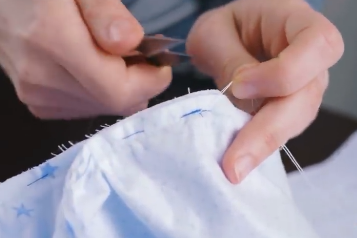We’ve developed thousands of technologies for space exploration, but they’re not just helpful for space.
我们已经开发了成千上万的太空探索技术,但它们不仅对探索太空有帮助。
Since 1976, NASA has been putting out a publication called Spinoff,
自1976年以来,NASA一直在刊发一份名为《Spinoff》的出版物,
which profiles some of the biggest technologies that began at NASA and are now helping life on Earth.
它介绍了一些源于NASA、如今正在帮助地球上的生活的重大技术。
And from masks for firefighters to supercharged computer networks,
从消防员用的口罩到超级计算机网络,
Spinoff 2020 is full of space-age technology that’s found its way into our lives.
2020年的《Spinoff》介绍的全都是融入了我们日常生活的太空时代技术。
First, those masks! If a fire happens on the International Space Station, it’s a big deal, and astronauts are trained to extinguish it.
首先,说说那些口罩!如果国际空间站发生火灾,这是一件大事,宇航员经过训练可以扑灭火灾。
And to protect them in the process, they’re equipped with masks made of ten layers of filtering material, mostly synthetic stuff.
为了在灭火过程中保护他们,他们需要佩戴有十层过滤材料的口罩,其中大部分都是合成材料。
These work great, but water vapor and really big or hot particles can clog the filter or melt the synthetics, limiting how long the masks can be useful.
这些方法效果很好,但是水蒸气和非常大或热的颗粒会堵塞过滤层或融化合成材料,这限制了口罩的使用时间。
So within the last few years, NASA contractors have set out to make some improvements to help the masks last as long as possible.
所以在过去的几年里,NASA的承包商们已经着手进行一些改进,让这些口罩尽可能耐用一些。
And they’re using an incredible new technology that promises to revolutionize filtration as we know it: wool.
他们正在使用一种令人难以置信的新技术,有望彻底改变我们所知的过滤技术:羊毛。
It turns out that wool makes a really good filter!
原来羊毛是很好的过滤器!
Because it contains lots of nitrogen and water, it’s got natural fire resistance, and because it’s super absorbent, it handles water vapor really well.
因为它含有大量氮和水,所以有天然的防火性能,还因为它有超强的吸收能力,所以能很好地吸附水蒸气。
The contractors reached out to a company in New Zealand called Lanaco, which makes wool-based air filters.
承包商联系了新西兰一家名为Lanaco的公司,这家公司生产以羊毛为基础的空气过滤器。
And together, they’re working on a mask pre-filter, something that will block big or hot stuff before the synthetic layers take over.
他们也在共同研究一种口罩预过滤器,它可以在非常大或热的东西到达合成材料层之前将其阻挡住。
They’re planning to use it for NASA’s fire masks, but also for firefighters on Earth.
他们计划将其用于NASA的防火面具,也可以供地球上的消防员使用。
And like, they’re going all in on it.
他们都全力以赴。
They are breeding sheep to produce wool with the perfect thickness, and they’re testing their prototypes with their local fire department.
他们正在饲养绵羊,让羊生产完美厚度的羊毛,还在当地消防部门测试口罩原型。
Also, because these filters are great with moisture, they’re good at absorbing breath and cough particles, too.
此外,因为这些过滤层能很好地吸附水分,它们也很好地吸收呼吸和咳嗽颗粒。
So Lanaco is even taking a version of this filter and putting it into masks to help prevent the spread of COVID-19!
所以Lanaco甚至将这种过滤层放入口罩中,以阻止新冠肺炎的传播!
So, this spinoff technology is finding yet another application by coming in clutch for healthcare providers.
因此,这项衍生技术有了另一种用途,它将成为医疗服务提供商的关键技术。
The next spinoff is also used in healthcare, but is way more sci-fi: robot hands.
下一个衍生产品也在医疗保健领域有所应用,但它更像科幻小说:机械手。
NASA’s Robonaut project is making humanoid robots to go places that are too dangerous for us, or to work alongside astronauts as an extra pair of hands.
NASA的Robonaut项目正在制造人形机器人,让它们代替人类去那些很危险的地方,或者作为多出来的一双手与宇航员一起工作。
But, well, hands are complicated.
但是,手是复杂的。
Each of your fingers needs to be able to sense how much pressure they’re applying in order to manipulate objects that are delicate or have weird shapes.
你的每根手指都要能感知到自己施加的压力,才能操作那些精致或形状怪异的物体。
And it’s hard to replicate that!
这一点是很难复制的!
But when NASA was looking for solutions to this problem in 2004, they realized they already had half the answer, because there was an old Spinoff project from 2002 that could do the trick.
但是2004年NASA在寻找这个问题的解决方案时,他们意识到他们已经有了一半的答案,因为有一个2002年的老项目可以解决这个问题。

It was developed by Intelligent Fiber Optic Systems, and it was a technology that could sense pressure for infrastructure purposes, like, to sense how much weight was on a bridge.
它是由智能光纤系统开发的,是一种可以在基础设施中感知压力的技术,比如,感知桥梁的重量。
It works by having tiny, compressible pieces alled fiber Bragg gratings, embedded in optical fibers.
它的工作原理是在光纤中嵌入微小的、可压缩的光纤布拉格光栅。
White light gets sent down the fiber, the grating splits the light into different colors, and then it reflects the light back to a sensor.
白光沿光纤传输,光栅将光分解成不同的颜色,然后将光反射回传感器。
But the key is, the colors of reflected light change depending on how stretched or compressed the grating is.
但关键是,反射光的颜色取决于光栅拉伸或压缩的程度。
If it’s stretched out, it sends back redder light, and if it’s compressed, it sends back bluer light.
如果它被拉伸,它会发出更红的光,如果它被压缩,它会发出更蓝的光。
And the sensor can turn that into a pressure reading.
而传感器可以把这转换成压力读数。
The company called their technology optical nerves, and NASA worked with them to adapt the idea for their robot’s fingers.
该公司称他们的技术为“光学神经”,NASA与他们合作,将这一想法应用到他们的机器人手指上。
In 2004, they were able to fit a bunch of these sensors into a small area, which was great!
2004年,他们已经能够在一片小区域内安装一堆这样的传感器,这真是太棒了!
Except, the whole setup was still too big, so it didn’t work out for the Robonauts.
不过,整个装置仍然太大,所以它不适合机器人。
Thankfully, the fiber optics company was able to find other uses for their new, souped-up system.
值得庆幸的是,这家光纤公司为他们的新系统找到了其他用途。
For example, they’re now developing pressure-sensitive biopsy needles for use in cancer treatment.
比如,他们现在正在开发用于癌症治疗的压敏活检针。
These tools can sense the density of the tissue surrounding them, which can help doctors differentiate between softer, healthy tissue and harder tumors.
这些工具可以感知周围组织的密度,这可以帮助医生区分较软、健康的组织和较硬的肿瘤。
And because fiber optics don’t interfere with MRIs, these needles can be used with real-time imaging, as well.
而且光纤不会干扰核磁共振成像,所以还可以在实时成像中应用这些针。
Oh, and also, the company has learned how to make their system a lot smaller and cheaper since 2004, so now, they are even revisiting the robotic hand idea, but as a prosthetic.
哦,还有,从2004年起,公司已经学会了如何使他们的系统更小更便宜,所以现在,他们又重新拾起了机械手的想法,不过是把它做成假肢。
Finally, supercomputers!
最后,还有超级计算机!
They’ve also gotten a lot smaller and cheaper in the last few years, and that’s because of another spinoff, called Beowulf clusters.
在过去几年里,超级计算机越来越小,越来越便宜,这是因为另一个衍生产品,贝奥武夫集群。
Back in 1993, supercomputers weren’t great.
早在1993年,超级计算机还不是很好。
They worked on the same basic principle as their counterparts today: a lot of processors are linked together to work in parallel and share a workload.
它们的工作原理与今天的处理器相同:很多处理器连接在一起并行工作并共享工作负载。
But they were also all running exclusive software on exclusive hardware, so they were really expensive, and they also crashed a lot.
但是它们也都是在专用硬件上运行专用软件,所以它们非常昂贵,而且还经常崩溃。
So for teams that needed to process a bunch of data and run simulations of like, big, universe-wide processes, teams like, you know, the ones at NASA, this was a bit of a problem.
所以对于那些需要处理大量数据并模拟整个宇宙过程的团队来说,比如NASA这样的团队,这是一个问题。
Then came two computer scientists: Thomas Sterling and Donald Becker.
然后出现了两位计算机科学家:托马斯·斯特林和唐纳德·贝克尔。
They realized you didn’t need fancy software to run supercomputers: Instead, you could just use Linux.
他们意识到,运行超级计算机不需要什么花哨的软件:相反,你只需要Linux。
It’s an open-source operating system, and most versions cost zero dollars.
它是一个源代码开放的操作系统,而且大多数版本都不花钱。
It’s also easy to learn and to customize.
它也很容易学习和定制。
Sterling and Becker realized that, if they ran Linux on a bunch of computers and linked them together,
斯特林和贝克尔意识到,如果他们在一堆电脑上运行Linux并将它们连接在一起,
they could make a cheap, easy-to-deploy supercomputer; one that could actually handle NASA’s big projects.
就可以制造出廉价、易于部署的超级计算机;可以处理NASA大项目的超级计算机。
So they linked together 16 computers and called it a Beowulf cluster.
因此他们将16台电脑连接在一起,并称之为贝奥武夫集群。
It’s a very good name that doesn’t actually have much significance.
这是个实际上没什么意义的好名字。
But oh, man, did these things take off, because it turns out, people don’t like bulky, expensive, buggy computers! Go figure!
但是,天哪,这些东西流行起来了吗?因为事实证明,人们不喜欢笨重、昂贵、有缺陷的电脑!自己去想吧!
In addition to NASA, national labs and universities use Beowulf clusters to run complex simulations and process terabytes of data in hours and days, rather than weeks and months.
除了NASA,国家实验室和大学都使用贝奥武夫集群来运行复杂的模拟,并在数小时或数天内处理兆兆字节的数据,而不是数周或数月。
So now, they’re used in industry for developing all kinds of products, from airplane wings to shoes.
所以现在,工业上会用它们来开发各种产品,包括飞机机翼和鞋子。
None of these technologies would exist if space explorers didn’t have a specific problem to solve.
如果太空探索人员不需要解决具体的问题,那这些技术就不会存在。
But luckily for us, sometimes those solutions apply to problems here on the ground, too.
但对我们来说幸运的是,有时这些解决方案也可以解决地球上的问题。
Thanks for watching this episode of SciShow Space!
感谢收看本期太空科学秀!
If you wanna learn about more space tech that’s shaped life on Earth, you can check out our episode from last year about Spinoff 2019.
如果你想了解更多塑造地球生活的太空技术,可以查看我们去年关于2019年的Spinoff节目。












